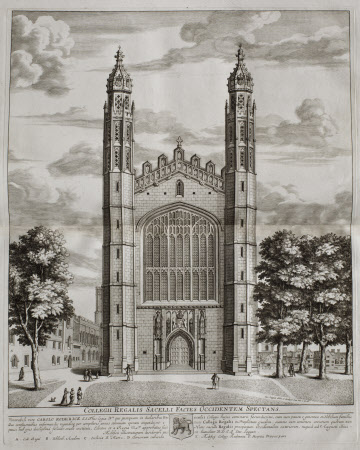Cantabrigia illustrata sive, Omnium celeberrimæ istius universitatis collegiorum, aularum, bibliothecæ academicæ scholarum publicarum sacelli coll: regalis nec non totius oppidi ichnographia / deliniatore & sculptore Dav. Loggan utriusque academiæ caleographo.
David Loggan (Gdańsk c.1634 – London 1692)
Category
Books
Date
1690
Materials
Place of origin
Cambridge
Order this imageCollection
Anglesey Abbey, Cambridgeshire
NT 3066028
Summary
David Loggan, Cantabrigia Illustrata, [Cambridge: s.n., 1690]. Binding: nineteenth-century half red morocco; marbled paper sides; spine gilt with title ‘Cantabrigia illustrata’; marbled endpapers.
Full description
Born of Scots descent in the Baltic port city of Danzig (now Gdańsk), David Loggan (1633-1700) was a pupil of the Dutch engraver Willem Hondius, and subsequently of Crispijn de Passe in Amsterdam. He moved from Holland to London between 1656 and 1658, and eventually found his way to Oxford. Appointed engraver to the university in 1669, he worked extensively for the university press, which had recently been refounded by the indefatigable John Fell (1625-86), Dean of Christ Church and (from 1676) concurrently Bishop of Oxford. Loggan produced many illustrations for Oxford books of the period, but his most famous and iconic publication was ‘Oxonia Illustrata’ (1675), a splendind picture book of views of the colleges and principle university buildings. By 1675 Loggan was in Cambridge, working on plates of Wren’s designs for Trinity College Library, and he seems to have started work on the companion ‘Cantabrigia Illustrata’ at about the same time, and certainly by 1679. Fell’s model in setting up the Oxford press had been the Imprimerie royale, the official French print-works, whose grandest books frequently had engraved title-pages and frontispieces, the preferred artist often being Poussin, just as Rubens had previously worked for the Plantin Press in early seventeenth century Antwerp. Loggan’s sometimes rather stiff draughtsmanship clearly did not compare to the work of these two great masters; unsurprisingly, his models were the Dutch engravers of his youth. But for all this, the publications of the Oxford press in the later seventeenth century are notable examples in their own right of the use of illustrations in scholarly books. The splendid copperplates in both ‘Oxonia’ and ‘Cantabrigia Illustrata’ were clearly popular, and copies were retained by both universities for presentation to benefactors and distinguished visitors. This popularity is reflected in fine bindings which adorn a good number of surviving copies (the National Trust owns an especially beautiful copy of ‘Oxonia Illustrata’ at Saltram in Devon, bound in London by the anonymous Queen’s Bidner B). Sensibly, while Lord Fairhaven owned only one copy of ‘Oxonia Illustrata’, he had two copies of the companion volume on nearby Cambridge – one elegantly bound and the other more obviously a reading copy. Text adapted from Mark Purcell's entry in ‘Treasures from Lord Fairhaven’s Library at Anglesey Abbey’, 2013, cat. 7, pp. 56-7.
Bibliographic description
[37] leaves of plates (some folded) : ill., map, port. ; fol. Shelved and uniform with his Oxonia illustrata. Imperfect: lacks frontispiece port. Plates mounted on nineteenth-century stubs, and some have paper repairs. Provenance: Gaddesden Park copy, with Gaddesden Library armorial bookplate annotated with shelfmark Case K, Shelf 2; ms. inscription “C.1.2. Gaddesden Park” on flyleaf. Twentieth-century armorial bookplate: Urban Huttleston Rogers Broughton [i.e. Urban Huttleston Rogers Broughton, 1st Baron Fairhaven (1896-1966), of Anglesey Abbey]. Pencil price on front free endpaper verso: £25 [for this book and Oxonia illustrata]. Binding: nineteenth-century half red morocco; marbled paper sides; spine gilt with title ‘Cantabrigia illustrata’; marbled endpapers.
Provenance
Purchased by the future Lord Fairhaven from Brown's Antiquarian Book Shop, Eton, 21 September 1928, together with the companion 'Oxonia Illustrata', for £25. Previously in the library of Gaddesden Park, Hertfordshire, home of the Halsey family (gutted by fire, 1905; abandoned, 1950) with its bookplate, and the shelfmark C.1.2. Bequeathed by Huttleston Rogers Broughton, 1st Lord Fairhaven (1896-1966) to the National Trust with the house and the rest of the contents in 1966.
Makers and roles
David Loggan (Gdańsk c.1634 – London 1692), engraver (printmaker)
References
Mark Purcell, William Hale and David Person, Treasures from Lord Fairhaven’s Library at Anglesey Abbey, Swindon: National Trust; London: Scala Arts & Heritage Publishers, 2013., pp. 56-7
